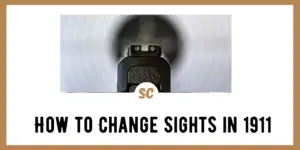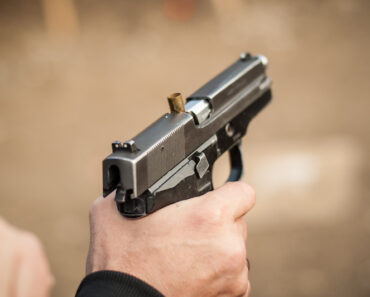Many shooters have a special place in the hearts for the venerable 1911 45 caliber semi-automatic pistol. This pistol served the US military faithfully from World War II until well into the middle of the 20th century. Thousands of shooters still enjoy the range time with their 1911. However, most shooters consider changing at least the front sights of their 1911 for an upgraded shooting experience. Changing sights on a 1911 can be challenging but can be accomplished successfully at home with a little preparation and patience.

Front and rear sight changes on a 1911 pistol require the old sights to be drifted out of the dovetail sight mount on the pistol side. New sights typically fit back into the dovetail without much problem. Removing and replacing the sights, both operations may require special tools to facilitate the project without damaging or marring the pistol parts. Replacing the sights on a 1911 can be accomplished by amateur gunsmiths; most shooters prefer to allow a professional gunsmith to perform this work.
If you prefer to perform your own minor gunsmithing, such as replacing the sights on your 1911 pistol, there are some tips and tricks that can help you make the job easier. Having the right tools on hand before you start is a key factor. There are also a few “inside secrets” that can make the job easier and the outcome more professional.
The Anatomy of a 1911 Slide – Front and Rear Sights
If you like the adage “Keep it Simple,” you are probably a fan of the 1911 pistol. This pistol design is nothing but simple. However, simple does not always mean easy when dismounting and mounting sights on a 1911 pistol slide. It is important to understand the design characteristics and the mechanics of working with the sight components on a 1911 slide.
The 1911 Front Sight Construction
On most standard 1911 pistols, the front sight is mounted to the front of the slide in a dovetail. The first concern with replacing the front sight of your 1911 pistol is to ensure that your replacement sight fits the dovetail cut onto your pistol slide. Different manufacturers use different dovetail specifications.
Some pistol manufacturers cut their dovetails to .340 inches. Others opt for a .330 inch dovetail cut. You must make sure that your new sights fit the dovetail cut for your pistol frame. If you aren’t sure, contact the manufacturer of the replacement front sight with your pistol specifications, manufacturer’s name, and serial number to ensure that you have the right size replacement front sight.
Tenon Staked Front Sights for 1911 Pistols
A few manufacturers, most notably Cold Series 80 1911-A1 pistols and some Rock Island Armory 1911 pistols, use a tenon to install the front sight on their pistols. The front sight post fits into a small square hole in the slide. The tenon post is staked into the frame to ensure that the front sight doesn’t change position. Staking is a method of deforming the metal of the front sight tenon to lock the tenon into place with the slide frame.
Some dovetail front sights are also stakes when installed and the pistol properly sighted. Staking is, on the surface, a rather simple operation, but without the proper tools and skills, you can damage the slide frame or the front sight. We almost always recommend that front sight removal and replacement be performed by a trained gunsmith with the proper equipment.
Rear Sight Construction on a 1911 Pistol
It is more common to find rear sight replacements on 1911 pistols than front sight changes. Many shooters prefer to upgrade the rear sights of their 1911 pistols, especially if they are active competitive target shooters. The range of styles and features available on replacement 1911 rear sights is unbelievably broad.
The most common mount found on many 1911 pistols is the standard GI dovetail cut. Thousands of pistols with this style of rear sight mount have been produced since the first 1911 frames rolled off the factory production line.
Several different companies have produced proprietary sight mounts for rear sights on 1911 pistols in recent years. The Novak LaMount system is probably the most popular for law enforcement and tactical shooting applications. The Novak mount is a lower profile mount that solves problems with holstering to prevent snagging of the sight.
Two other companies deserve mention as well. Bomar and LAP-TRT both manufacture 1911 rear sights geared toward the competitive shooting market. These sights tend to have a higher profile and more sensitive adjustments than other styles. However, these styles of 1911 rear sights require special holster adaptations.
You must understand that these manufacturers require a different dovetail cut for proper installation. If your 1911 has a standard GI dovetail cut on the rear of the pistol slide, these dovetails must be recut and machined to fit one of these other sights. Only a properly trained gunsmith with a well-equipped machine shop should make these kinds of adjustments to your 1911 pistol.
Changing Sights on a Standard 1911 Pistol
There are so many variants of pistol sight mounts used on 1911 style pistols that it is almost impossible to give an exact step-by-step method for making a change. The most common front and rear sight mounts on GI issue-style 1911 pistols are standard dovetails, probably the easiest to change.
Before you begin changing the front and rear sights on your 1911 pistol, you should understand that there is a significant risk that you can damage the sight or the slide frame of your pistol. Professional gunsmiths have the jigs, mounts, and tools to perform these changes. Trying to “make do” with what you have around your home shop may lead to disaster.
Front Sight Changes to a Standard 1911 Dovetail
These steps should help you change the front sight on your 1911 standard GI issue dovetail sight. Before you begin, make sure that the size of the dovetail on your pistol is the same as the dovetail on your new sights.
Step 1: Practice Good Gun Safety
Before doing anything else, make sure that your 1911 pistol is in a safe condition. Remove the magazine and clear the chamber. Visibly check the chamber for any live round. Remover the slide and disassemble the components leaving only the slide and the mounted sights.
We recommend that live ammunition never be kept in the same area where you perform gunsmithing work. Keep your ammunition physically segregated in another room and safely locked in a metal cabinet.
Always wear your safety equipment when working with your firearms. Eye protection is a must, and many people prefer to wear hearing protection in the shop.
Step 2: Have the Correct Tools on Hand
For most 1911 pistols with standard dovetail sight mounts, the tools required to remove and replace the front sights are few. We suggest that before you begin the process of removing your front sights, you have all the necessary tools and other equipment on hand. This will prevent frustration and make the project flow smoothers from start to finish. We suggest the following tools at a minimum.
- A padded gun vise or adaptable jig to hold the slide of your 1911 pistol firmly without deformation, twisting, or binding.
- A set of brass punches
- A brass gunsmiths hammer
- Gu oil
- Your replacement sights
Many gun owners also employ a hobbyist lighted magnifier mounted on their workbench. This can make seeing the small details of your pistols sight mounts easier.
Step 3: Secure the Pistol Slide in the Vice
Place the slide from your 1911 into your padded gun vice. Ensure no metal-to-metal contact between the vice and the pistol slide. Secure the pistol slide so that the front sight is easily accessible. Don’t apply too much force to the vice. However, the pistol slide frame should not move easily as you work on the front sight.
Step 4: Remove the Original Front Sight
Using a properly sized brass punch, drift the front sight out of the dovetail cut with the brass hammer. Work slowly to ensure that you don’t mar the finish on your pistol slide. We suggest that you work from left to right, tapping the brass punch until the front sight begins to move down the dovetail.
Before removing the original front sight, we suggest you use a bit of metal workers’ chalk to mark the center of the original front sight. This will make positioning your new front sight a bit easier.
Step 5: Inspect the Dovetail Cut on your Pistol and Install the New Sight
Inspect the inside of the dovetail cut on your pistol. It should be smooth and free of any burrs or scratches. Clean the dovetail carefully, and then apply a small amount of high-quality gun oil to the dovetail to make inserting the new sight a bit easier.
Getting the new front sight started maybe a bit tricky. Work slowly without forcing the sight until it begins its journey down the dovetail cut. Center the new front sight with the chalk of the original front sight.
You will still need to spend time at the range getting the new front sight into the proper position.
Step 6: Staking the Sight
Many 1911 shooters prefer to stake the front sight once they have it properly. If the sight is well manufactured and fits correctly in the dovetail, more than likely, staking won’t be necessary. If you do decide to stake the front sight, proceed carefully.
Changing the Rear Sight on your 1911 Pistol with a Standard Dovetail Cut
Changing the rear sight on your 1911 pistol is not much different than changing the front sight. Replacing the rear sight takes a bit more care. Most replacement rear sights for 1911 pistols include windage and elevation adjustments that can be damaged when drifting the sight back into place. Some specialized tools clamp onto the slide and use a torsion screw assembly to push the old sight out of place and the new sight down the dovetail. These devices are much more accurate and less likely to mar your pistol than a hammer and a punch.
Step 1: Work Safely
Safety in the gunsmithing shop is always the priority issue. Make sure your pistol is in a safe condition before doing anything else. Disassemble the pistol and store the parts safely while working on the slide frame. Always wear your personal safety equipment.
Step 2: Gather your Tools and Equipment
The same basic tools and equipment are used to replace the rear sight on a standard 1911 GI issue pistol. If you are replacing your rear sight with another brand, such as a Novak mount, you may need specialized tools to make the change without damaging the new sight or your pistol.
Step 3: Secure the Slide in the Vice
Secure the slide frame of your 1911 pistol in the vice. Ensure that the rear dovetail is clear of the vice and any other jigs or padding. We suggest that you work from left to right to remove and replace the rear sights on your 1911 pistol.
Step 4: Drift the Original Rear Sight Out of the Slide Frame
Work slowly and carefully. Small hammer taps on the punch are better than big heavy blows. It may take a bit of time to get the old sight started. This can be true if the old rear sight is staked into position. Don’t get frustrated.
Step 5: Start the New Rear Sight and Slowly Move it Into Position
It may take a bit of work to get the new rear sight started into the dovetail cut. The sight must fit tightly to ensure accuracy once it is in position. A touch of gun oil in the dovetail may help at this point. Work slowly and precisely to move the new rear sight into position.
A rear sight tool designed for your new rear sight may make this operation easier. Check with your new rear sight manufacturer for their recommendations for special tools to install your new rear sight.
Step 6: Off to the Range for Zeroing
With your new rear sight installed, it is off to the range to do the final zero on your pistol sights. Be sure to take the appropriate tools to adjust your sights’ windage and elevation to your precise needs.
Front and Rear Sight Replacement on Your 1911
In truth, there is nothing esoteric or particularly difficult about replacing the front and rear sights on a standard 1911 dovetail mount. The most important factors are having the right tools and working slowly and precisely. Remember that the standard GI issue 1911 was designed for simplicity and to make field repairs as quick and easy as possible.




![Strategic Relocation With Joel Skousen [PODCAST] Strategic Relocation With Joel Skousen [PODCAST]](https://survivalcove.com/wp-content/uploads/2022/03/Modern-Combat-and-Survival-Podcast-370x297.jpg)






















